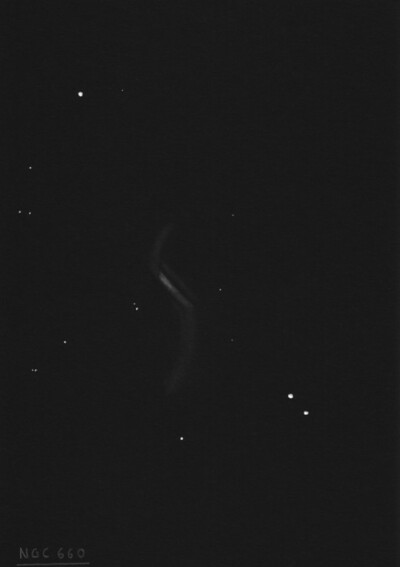
William Herschel discovered NGC 660 = H II-253 on 16 Oct 1784 (sweep 295) and noted "pB, pl, E, bM, r". Sir Robert Ball, an assistant with the 72" at Birr Castle, described "a fine neb of the character of the neb in Andromeda. cB, vL, E 37.1°, possibly curved and with details. E Nucl which was suspected to be in two parts or have some peculiarity." A later observation by Dreyer reads "pB, pL mE 41°. Looks like a brush, fades away gradually south-following, more sharply defined north-preceding. Condensation in nf end."
400/500mm - 17.5" (12/18/89): fairly bright, large, oval SW-NE, broadly concentrated halo, mottled. A mag 14 double star is 1.8' ESE of center. Located 10' SE of mag 8.1 SAO 92589. UGC 1195 (possibly = IC 148) lies 22' NNW. It appeared faint, moderately large, oval SW-NE, low even surface brightness. NGC 660 and IC 148 are members of the loose M74 group.
900/1200mm - 48" (10/23/11): this large, striking galaxy contains a very bright, elongated bar oriented SW-NE, ~2'x1'. The northeastern half of the bar is noticeably brighter with a very high surface brightness. The galaxy is fainter and wider on the southwest portion of the bar. The central region in mottled and dusty, but I didn't notice the X-shaped dust lanes visible on photos. At the southwest end, a broad low surface brightness spiral arm emerges and sweeps south, curving slightly east for a length of 2'. A second faint arm begins at the northeast end of the bar and extends north a similar distance, bending gradually to the west. The arms gave the galaxy a stretched "S" appearance and significantly increased the overall size to ~6.5'x2.5', roughly N-S.
Notes by Steve Gottlieb